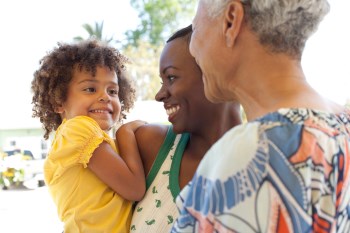 Instructions: Read the scenario. At the end, you will find related questions for reflection based on your role. Take a moment to reflect on each question.
Instructions: Read the scenario. At the end, you will find related questions for reflection based on your role. Take a moment to reflect on each question.
Scenario 3: Grandmother's Song
A home visitor sits on a living room sofa with the parents of 4-year-old Ayana, who is enrolled in a Head Start program. She shares written observations from a portfolio put together by Ayana's teacher. They are talking in the family's home language. The notes she shares are written in the family's home language and English, because the child's parents, teacher, and home visitor are fluent in both.
As the home visitor talks with the parents and Ayana plays nearby, she hears conversation from another part of the house. She thinks she recognizes the voice of the family's 2-year-old child, Ines. Soon, she hears giggling and sees Ines leave the kitchen smiling and carrying a piece of fruit. Ines motions toward her parents and the home visitor.
Almost immediately, an older woman becomes visible in the kitchen doorway and says a few words to Ines in a language that is new to the home visitor. The mother smiles and addresses Ines in the same language, directing her back to the table in the kitchen. The mother then comments to the father and home visitor, "I think she will be okay in there with my mother until we are finished."
The home visitor wonders what language they are speaking. She did not realize that there was another language spoken in the home. The home visitor and parents continue to talk, and after a little while Ines comes from the kitchen again, looking sleepy. She walks toward her mother. This time, Ayana approaches her sister and speaks to her in the language that is new to the home visitor. The sisters begin to laugh as they walk toward their bedroom.
The home visitor now realizes that the children are actively using three languages. She smiles and says to the mother, "I hear you speaking another language with your children and mother." "Yes," she replies, "at home we speak two languages other than English. My mother and I come from the northwest part of our country where we use a different language. We speak our language at home with the girls." Her husband adds, "I don't speak it, though, and my mother-in-law doesn't speak any other languages, so it's especially important for our children to know both. We don't want them to lose either of our family languages."
From where she is sitting, the home visitor can see inside the children's bedroom. Ines is beginning to fall asleep in her bed as Ayana sings her a quiet song in her mother and grandmother's language.
Reflections
Program Staff
This family has clearly articulated that they strongly value all of the languages spoken in their home and recognize that maintaining them supports strong family relationships.
- How might the additional language information inform the ways staff support family relationships and goals in their daily work with this child and family?
- Do you work with multicultural or multilingual families? How do you support their unique learning goals and needs?
- What are some reasons the family might not have initially shared or had an opportunity to share information about all of the languages spoken in their household?
- What else might the home visitor learn from the family in order to support the family's goals, desires, and relationships?
- What aspects of your personal culture or traditional practices differ from those of your colleagues or the families in your program?
Program Managers and Leadership
- Do staff include individuals that speak the languages of, belong to, or have knowledge of the communities and cultures of the children and families enrolled in your program? If so, what do you know about how those staff feel about the role they play in your program of helping other staff understand these cultures and communities? How can you learn more?
- What strategies do program staff use to support home languages?
- Do children, families, and staff have opportunities to learn about and share community, cultural, home language-based, and traditional activities, practices, and information?
- Are there resources, organizations, or agencies in your community that support the cultural heritage of children, parents, and families enrolled in your program? If so, does your program build ongoing relationships with them?
« Go to Cultural Perspectives in Caregiving: Applying Relationship-Based Practices
Last Updated: July 29, 2019
